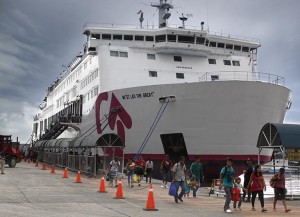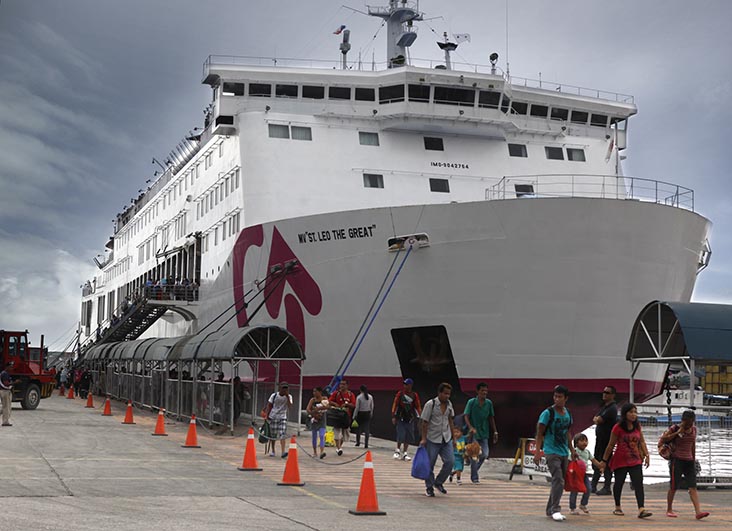 BATANGAS CITY, PHILIPPINES — Philippine shipping lines are keeping a positive eye on 2014 after a challenging 2013.
BATANGAS CITY, PHILIPPINES — Philippine shipping lines are keeping a positive eye on 2014 after a challenging 2013.
Meridian Cargo, a carrier initially formed to cater to the agricultural business of the Tio family, had a sound 2013 as it cornered cargoes of some multinational companies shipping to Palawan.
Meridian assistant general manager Christina Tio described 2013 operations as “better than 2012 by 30%”. This is despite higher costs that came about after super typhoon Yolanda in late 2013 hit Tacloban, the only other route served by Meridian apart from Palawan.
This year, expansion is in the works with the addition of a new route and the purchase of a 3,000-gross tonnage vessel and 300 container vans.
Meridian Cargo was one of the Philippine Liner Shipping Association member carriers that recently went on a Batangas port tour to assess the viability of shipping through that port. The use of Batangas and Subic ports has gained greater currency of late following Manila’s imposition of a daytime truck ban.
Another all-cargo carrier that felt the wrath of Yolanda was Moreta Shipping Lines.
Officer-in-charge Melody Moreta said 2013 was “not as good as the other year” with delays recorded in the fourth quarter, normally considered peak season.
She told PortCalls maintenance costs due to drydocking shot up yet the company managed to post break even numbers in 2013. This year, a 30% growth is forecast for new routes, Bacolod and Iloilo.
Listed company Lorenzo Shipping Corp (LSC) also had a breakeven year in 2013.
LSC vice president Jun Saldaño said while last year’s revenue was up, they were not enough to offset expenses from maintenance and dry docking.
Saldaño is confident the company’s fortunes will turn. “It should be positive this year.”
LSC acquired 800 container vans in 2013 and intends to buy 800 more this year, Saldaño said.
The carrier is replacing one of its small vessels in May with one that has a capacity of 250 twenty-foot equivalent units (TEU).
As for expansion, Saldaño said that’s “always in the plan” but will depend on the company’s purchase of a smaller vessel.
LSC vessels are normally in the 250-400 TEU range, which cannot be accommodated in smaller ports, the shipping line executive pointed out.
Gothong Southern Shipping Lines, Inc. posted a 15-20% growth last year as it added another vessel to its fleet.
Gothong Southern Manila operations vice president Rex Yuvienco said the liner handled more manufacturing and forwarding accounts, mostly in its Cebu hub.
He said the company ordered 800 container vans in 2013. Last February, 600 container vans – on top of the 800 already on order – arrived. An additional 500 boxes are expected this year.
Yuvienco said Gothong is looking at new routes such as Bacolod, Iloilo, Ozamiz and Butuan.
Re-fleeting has been a “continuous process” in the past three years for Philippine Span Asia Carrier Corp. (formerly Sulpicio Lines), according to vice president Dexter Go.
“We’re now focusing more on the cargo side. We only have two passenger vessels,” Go said.
The company has 15 vessels deployed in 16 ports. There are no concrete plans of acquiring new vessels or expanding into new routes.
Inefficiencies
While the fortunes of domestic carriers are mixed, all agree that inefficiencies — in part due to lack of infrastructure especially in outports – abound, leading to additional costs and delays in operations.
Moreta noted local liners sometimes need to invest in self-sustaining vessels because some ports do not have their own equipment, adding “there’s not much government infrastructure in place.”
She pointed out, “There’s much room for growth in their (outports) efficiency levels. We cannot do it on our own. We need support.”
Go, Yuvienco and Saldaño said berths are also a problem, all citing the Port of Cebu as an example.
“The cargo volume at Cebu is growing substantially and it seems like the port is very congested. In short the port is not able to keep up with the growth,” Go said.
Saldaño added their vessels sometimes cannot get anchorage “for about a day and a half” in the Visayan port.
Another burden on domestic carriers is taxes on fuel. Lines complain of the field not being level because foreign carriers operating in the Philippines do not have to pay the fuel tax.
“Fuel is a major expense for shipping lines. If we will be taxed, we will not be competitive with foreign carriers,” Saldaño said.
Asked about their preparations for ASEAN economic integration in 2015, Yuvieco said Gothong sees 2015 as “a very, very competitive year”.
He explained integration will bring more cargoes but will also mean greater competition.
Competition from foreign shipping lines may not come automatically though. With their bigger vessels, foreign carriers “cannot just get into (our) ports; we have draft issues, we have berthing issues,” Yuvienco said.
Saldaño added foreign lines will only be able to enter the Philippine market on a “limited sphere” due to the limited volume, noting they will in addition “have a problem” with the way “domestic shipping business is being run here.” – Roumina Pablo
Photo courtesy of Manila North Harbour Port, Inc





